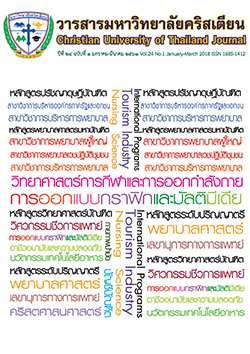ปัจจัยที่มีอิทธิพลต่อศักยภาพระบบสารสนเทศทางการบัญชีบริหาร: หลักฐานจากธุรกิจเครื่องดื่มในประเทศไทย
คำสำคัญ:
ศักยภาพระบบสารสนเทศทางการบัญชีบริหาร, ธุรกิจเครื่องดื่มบทคัดย่อ
การวิจัยครั้งนี้มีวัตถุประสงค์เพื่อศึกษาปัจจัยที่มีอิทธิพลต่อศักยภาพระบบสารสนเทศทางการบัญชีบริหาร โดยปัจจัยที่ศึกษา ได้แก่ การสนับสนุนของผู้บริหาร ทรัพยากรเทคโนโลยีสารสนเทศ การเรียนรู้ทางเทคโนโลยีของพนักงาน ระบบบัญชีที่ดี และสภาพแวดล้อมที่เอื้ออำนวยโดยรวบรวมข้อมูลจากธุรกิจเครื่องดื่มในประเทศไทย จำนวน 141 บริษัท สถิติที่ใช้คือการวิเคราะห์ความถดถอยพหุคูณ
ผลการทดสอบเชิงประจักษ์พบว่าปัจจัยสำคัญ ได้แก่ ทรัพยากรเทคโนโลยีสารสนเทศ และการเรียนรู้ทางเทคโนโลยีของพนักงาน มีอิทธิพลเชิงบวกต่อศักยภาพระบบสารสนเทศทางการบัญชีบริหาร ผลการวิจัยนี้เป็นประโยชน์สำหรับผู้บริหารองค์กรในการจัดสรรงบประมาณเพื่อการลงทุนทรัพยากรด้านเทคโนโลยีสารสนเทศและเพื่อส่งเสริมการเรียนรู้เทคโนโลยีให้กับพนักงาน ซึ่งเป็นแนวทางในการเพิ่มศักยภาพระบบสารสนเทศทางการบัญชีบริหาร
References
Anderson, S.W. & Lanen, W.N. (1999). Economic transition, strategy and the evolution of management accounting practices: The case of India. Accounting, Organizations and Society, 24, 379-412.
Armstrong, J.S. & Overton, T.S. (1977). Estimating non-response bias in mail surveys. Journal of Marketing Research, 14(3), 396-402.
Ax, C., Greve, J. & Nilson, U. (2008). The impact of competition and uncertainty on the adoption of target costing. International Journal of Production Economics, (115), 92-103.
Bagranoff, N., Simkin, M. & Norman, C. (2010). Core Concepts of Accounting Information Systems. 11th ed. New Jersey: John Wiley.
Berry, W.D. & Feldman, S. (1985). Multiple Regressions in Practice. Newbury Park (CA):Sage Publications.
Bharadwaj, A. (2000). A resource-based perspective on information technology capability and firm performance: an empirical investigation. MIS Quarterly, 24(1), 169-196.
Bi, R., Davison, R.M. & Smyrnios, K.X. (2013). The effect of IT complementary resources on fast growth small-to-medium enterprise performance: A Resource-based View. Taiwan. The Pacific Asia Conference on Information Systems 2013 Proceedings.
Boulianne, E. (2007). Revisiting fit between AIS design and performance with the analyzer strategic type. International Journal of Accounting Information Systems, (8), 1-16.
Byrd, T.A. & Turner, D.E. (2000). Measuring the flexibility of information technology infrastructure: exploratory analysis of a construct. Journal of Management Information Systems,17(1), 167-208.
Cadez, S. & Guilding, C. (2008). An exploratory investigation of an integrated contingency model of strategic management accounting. Accounting, Organizations and Society, 33(7-8), 836-863.
Chaikambang, C., Ussahawanitchakit, P. & Boonlua, S. (2012). Strategic cost management and goal achievement: evidence from food businesses in Thailand. International Journal of Business Strategy, 12(4), 1-30.
Choe, J.M. (1998). The effects of user participation on the design of accounting information systems. Information and Management, 34(3), 185-198.
Chong, V.K. (1996). Management accounting systems, task uncertainty and managerial performance: a research note. Accounting, Organizations and Society, 21(5), 415-421.
Chong, V.K. & Rundus, M.J. (2004). Total quality management, market competition and organizational performance. The British Accounting Review,(36), 155-172.
Dechow, N. & Mouritsen, J. (2005). Enterprise resource planning system, management control and quest for integration. Accounting, Organization and Society, (30), 691-733.
Dixon, N.M. (1999). The organizational Learning Cycle: How we can Learn Collectively. 2nd. .Gower.
Goll, I. & Rasheed A.M.A. (1997). Rational decision-making and firm performance: the moderating role of environment. Strategic Management Journal, 18(7), 37-53.
Goll, I. & Rasheed, A.A. (2004). The moderating effect of business environmental munificence and dynamism on the relationship between discretionary social responsibility and firm performance. Journal of Business Ethics, (49), 41-54.
Grabski, S.V. & Leech, S.A. (2007). Complementary controls and ERP implementation success. International Journal of Accounting Information Systems, 8(1), 17-39.
Hair, J.F., Black, W.C., Babin, B.J. & Anderson, R.E. (2010). Multivariate Data Analysis. 7th ed.Upper Saddle River, New Jersey: Pearson Education International.
Hansen, D.R. & Mowen, M.M. (2007). Managerial Accounting. 8th ed. USA: Thomson.
Heidmann, M., Schaffier, U. & Strahringer, S. (2008). Exploring the Role of management accounting system in strategic sensemeking. Information system Management,(25), 81-99.
Henri, J.F. (2006). Organizational culture and performance measurement systems. Accounting,Organizations and Society, (31), 77-103.
Holmes, S. & Nichlos, D. (1988). An analysis of the use of accounting information by Australian small business. Journal of Small Business Management, 26(2), 57-68.
Hussain, M., Gunasekaran, A. & Latinen, E.K. (1998). Management accounting systems in Finnish service firms. Technovation, 18(1), 57-67.
Ismail, N.A. & King, M. (2005). Firm performance and AIS alignment in Malaysian SMEs.International Journal of Accounting Information Systems, (6), 241-259.
Kalagnanam, S.S. & Lindsay, R.M. (1999). The use of organic models of control in JIT firms:generalizing Woodward's findings to modern manufacturing practices. Accounting,Organizations and Society, (24), 1-30.
Kara, E. & Kilic, Y. (2011). Accounting recording system on accrual basis at local authorities in Turkey: An application in Gaziantep Local Municipality. International Journal of Business and Social Science, 2(15), 244-250.
Kokfai, S., Pratoom, K. & Muenthaisong, K. (2016). Strategic entrepreneurial capability and service success: An empirical investigation of spa businesses in Thailand. Ph.D. Dissertation, Mahasarakham Business School, Mahasarakham University. Thailand.
Konthong, A. & Ussahawanitchakit, P. (2010). AIS competency, accounting outcomes, and firm performance: An empirical study of Thai-List firms. JIMS, 10(4), 43-67.
Lee, C.L. & Yang, H.J. (2011). Organization structure, competition and performance measurement systems and their joint effects on performance. Management Accounting Research, 22(2), 84-104.
Stull, A.J., Cash, K.C., Johnson, W.D., Champagne, C.M., and Cefalu, W.T. (2010). Bioactives in Blueberries Improve Insulin Sensitivity in Obese, Insulin-Resistant Men and Women. The Journal of Nutrition. (140), 1764-1768.
Thomas, N., Alder, E., and Leese, G. P. (2004). Barriers to physical activity in patients with diabetes. Postgrad Medical Journal. 80(943), 287-91.
Weisel, T., Baum, M., Eisenbrand, G., Dietrictch, H., Will, F., Stockis, J.P., Kulling, S., R fer, K., Johannes, C., and Christine Janzowski, C. (2006). An anthocyanin/polyphenolic rich fruits juice reduces oxidative DNA damage and increase glutathione level in healthy probands. Biotechnology Journal. (1), 388-397.
WHO. (2016). Obesity and overweight. [Online]. Retrieved March 2, 2013, from http://www.who.int/mediacentre/factsheets/fs311/en/.



